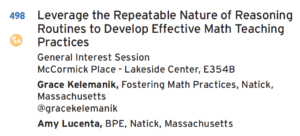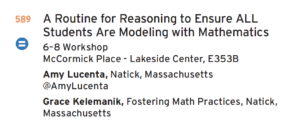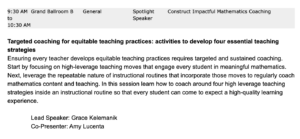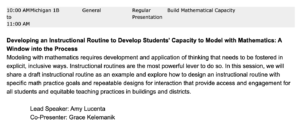Each year Quinn plants 24 flowers in his garden. This year he planted only red and purple flowers. Quinn prefers purple, so he planted twice as many purple flowers as red flowers. [How many purple flowers did Quinn plant?]
Back to Capturing Quantities Tasks
-
Tue07Jan2020Wed08Jan20208:30 am - 3:00 pmSEEM Collaborative, Stoneham MAThis two-day course will provide teachers with 4 research-based strategies to teach students with learning disabilities how to think and reason mathematically. Participants will leave: Understanding what it looks like when students reason mathematically – quantitatively, structurally, and through repetition. Knowing 4 essential strategies to engage students, support their development of mathematical thinking, and develop independence. Ready to support each and every learner to develop as mathematicians.
-
Thu16Jan2020Fri17Jan2020Stockton, CA
-
Wed22Jan2020Tukwila, WA
-
Thu23Jan2020Fri24Jan2020Santa Maria, CA
-
Tue28Jan2020Danvers, MA
-
Thu30Jan2020
-
Mon03Feb2020
-
Wed05Feb2020Pleasant Hill, CA
-
Wed05Feb2020Thu06Feb2020West End Education Services Center Rancho Cucamonga, CA
-
Wed04Mar2020Sat07Mar2020Portland, OR
Learn more about the seminar and pre-session - Leverage the Repeatable Nature of Reasoning Routines to Develop Equitable Math Teaching Practices - on the Teachers Development Group website https://www.teachersdg.org/leadership-seminar/
-
Tue10Mar2020Wed11Mar2020North Reading High School North Reading, MA
Essential Strategies for Teaching Students with Learning Disabilities to Think Mathematically
-
Thu12Mar2020Danvers, MA
-
Thu19Mar2020Fri20Mar2020Norristown, PA
-
Mon23Mar2020Tue24Mar2020Frisco, TX
-
Mon30Mar2020Wed01Apr2020
-
Wed01Apr2020Sat04Apr2020Chicago, Il
Amy and Grace are Speaking Friday at 2:30 and Saturday at 8:00


Click here for more about NCTM's 100 Celebration
-
Fri06Nov2020Sat07Nov2020https://www.cmc-math.org/virtual-conference
-
Tue10Nov2020
-
Thu12Nov2020
-
Thu12Nov2020Sat14Nov2020
-
Tue24Nov2020
-
Tue01Dec2020
-
Thu03Dec2020



Comments are closed.
I introduced this routine the first time during our first full week of school. We’ve been talking about growth mindset, and students had identified math (and specifically work problems) as an area where there was a need. The first go round was hardest for the students who just wanted to solve the problem. By the second time, students were more fluid and fluent within the routine. By our last presentation of this routine, students were able to talk about the story and (excitedly) explore each other’s thinking. The meta reflections were very informative! I was pleased and surprised by a couple of students’ reflections that indicated a better acceptance of and understanding of the routine as well as their mathematical thinking.
I also thought that the meta reflections were informative. Sometimes I forget to do this step, but it truly is valuable.
I used this task as a introduction to the Capturing Quantities Routine with my 7th grade special education students. I was pleasantly surprised with how quickly they jumped into the routine and that they all created fraction models (bar and pie) to represent the important information accurately. We had already done the Three Reads Routine multiple times, so I think that helped and I noticed them applying their strategies and vocabulary of quantities and relationships. It was a positive first experience for all of us and they were excited for a more challenging problem to follow!
I introduced this routine to a small group of students during a WIN (What I Need) block. I focused on this group of students because they are the typical general education student who needs to focus on the important information in the question. These students have decided their goal with me and capturing quantities (and the 3 reads they have already explored) should help them with their goal.
The first go around with this routine the students were hesitant, but pushed through the routine. They were able to identify the important quantities and relationships between the colors of flowers and how many flowers were planted each year. This routine allows students to slow down and really understand the relationships in the given problem.
I used this as my second task with a fifth grade class learning the Capturing Quantities routine. I had left off the question with the first task I had done – with great success – so I left it off again. The best part of this one was the diagrams students drew – they were much clearer (partly due to the content, partly due to the fact that it was the second time) in terms of how they showed the relationships between the flower colors. Many used an area type model because it was a garden and few students used a bar model which they had a lot of previous experience with in fourth grade. On this problem, we were really able to focus in on stating quantities as quantities, and not just giving the number, so “the number of red flowers”, etc. The problem lent itself well for this! I knew students were getting comfortable with the routine so for the 3rd task, I chose a pretty challenging one for them: Nuna’s Age